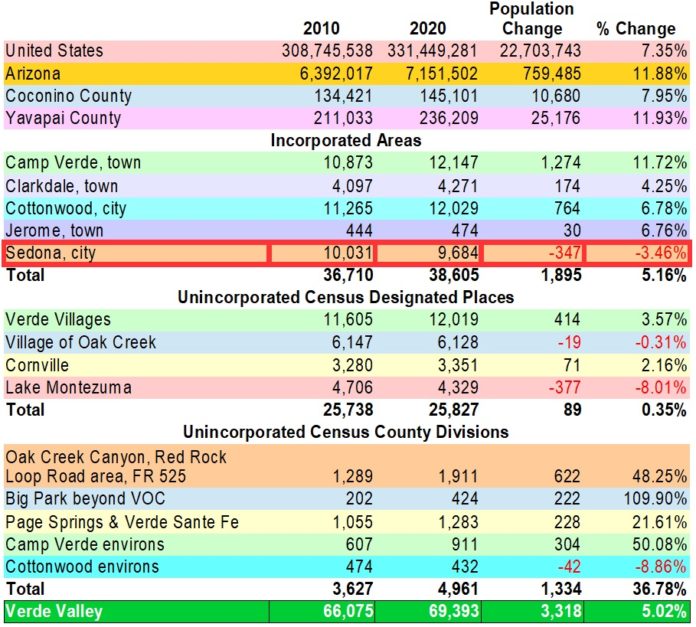The 2020 census is firmly established that the Verde Valley is rapidly increasing while the Sedona area is seeing a shrinking population size. Based only on residents inside the official jurisdiction, Camp Verde is now the largest incorporated town in the Verde Valley with 12,147 residents.
While the Verde Villages are considered part of Cottonwood, and many new residents often mistakenly believe they are Cottonwood residents due to their mailing address and water bill, they are outside the city in unincorporated Yavapai County jurisdiction. The 12,029 people of Cottonwood and 12,019 of the Verde Villages are the largest combined population block in the Verde Valley as a whole.
Part of the shrinkage of Sedona — which lost 350 residents between 2010 and 2020 — and the Village of Oak Creek — which lost 20 people in the same time frame — is largely due to the increase in vacation rentals, which are quickly diminishing the amount of housing options in the already overpriced Sedona market.
However that unfortunate trend only started after the passage of Senate Bill 1350 in 2015. The slower and systemic demographic shift is from the overall general aging of the population in Sedona and the Village of Oak Creek. A home that formerly rented for $1,500 a month for a family is being rented out for $4,000 a month to a senior couple or sold off and has a mortgage of about the same, which mainly only seniors can afford due to large nest eggs or a lifetime of accumulated wealth to spend on a final dream home in retirement.
A few YouTubers, Instagramers and organic, vegan, fair-trade, eco-friendly gluten-free trustifarians, chakranauts and life coaches also buy such homes in Sedona because they can seemlessly co-create and crowdsource with stakeholders a habitation platform to pilot their client target brand development strategy … or some such nonsense.
The slide can be seen in the decade-long student population drop in the Sedona-Oak Creek School District that serves both the Sedona and Village of Oak Creek communities.
Conversely, the Cottonwood, Camp Verde and Clarkdale are growing — Cottonwood quite literally with the annexation of nearly 11 square miles most of which will remain U.S. Forest Service land and never be developed, but with the proposed Spring Creek Ranch housing development that could add hundreds if not a few thousands residents should the proposal be approved by Cottonwood leaders.
Housing developments are springing up all over Cottonwood area and housing projects that stalled after the Great Recession a decade ago are restarting or growing.
The addition of RV parks in Camp Verde add short-term but consistent populations that will increase the population for years to come.
The COVID-19 pandemic upended many things, not least of which is nationwide job market. The sudden conversion of on-site office jobs to remote positions means many white-collar workers can essentially live anywhere and tens of thousands decided to leave major cities and move to rural areas like ours where they can have big city paychecks and small-town lifestyles.
How exactly this will change them or our towns remains to be seen as the big city or even suburban demands or way of doing things doesn’t always jive with small town familiarities. Small communities will need to decide whether to stay strong in the face of outsider pressure demanding they change or whether they choose to adapt their communities . For instance, an ex-big city customer may be having what they deem as a “crisis,” but one that isn’t as important as one by longtime local customer, meaning they’ll have to wait. Fewer vendors or merchants also means longer wait times or a lack of alternatives.
Small town residents live in small towns because they don’t often want the cutthroat attitude and anonymity so new residents may learn the hard way how smaller communities get things done.
How our communities change after COVID-19 will be as important as how our communities changed after the Great Recession a decade ago.
Christopher Fox Graham
Managing Editor



















